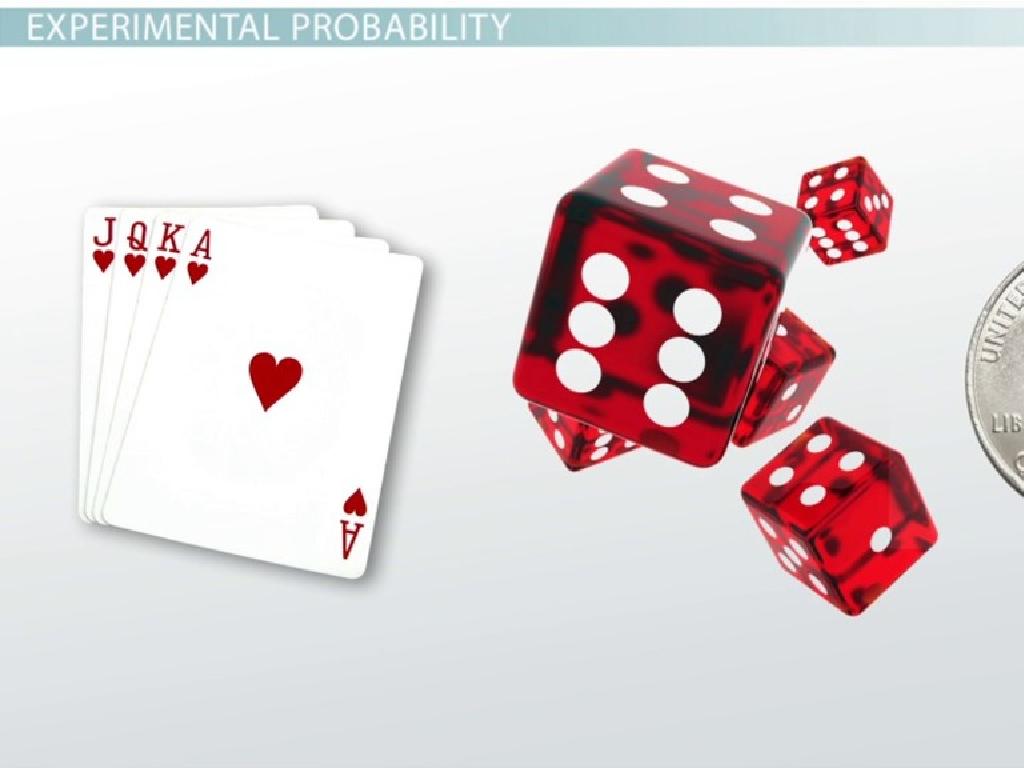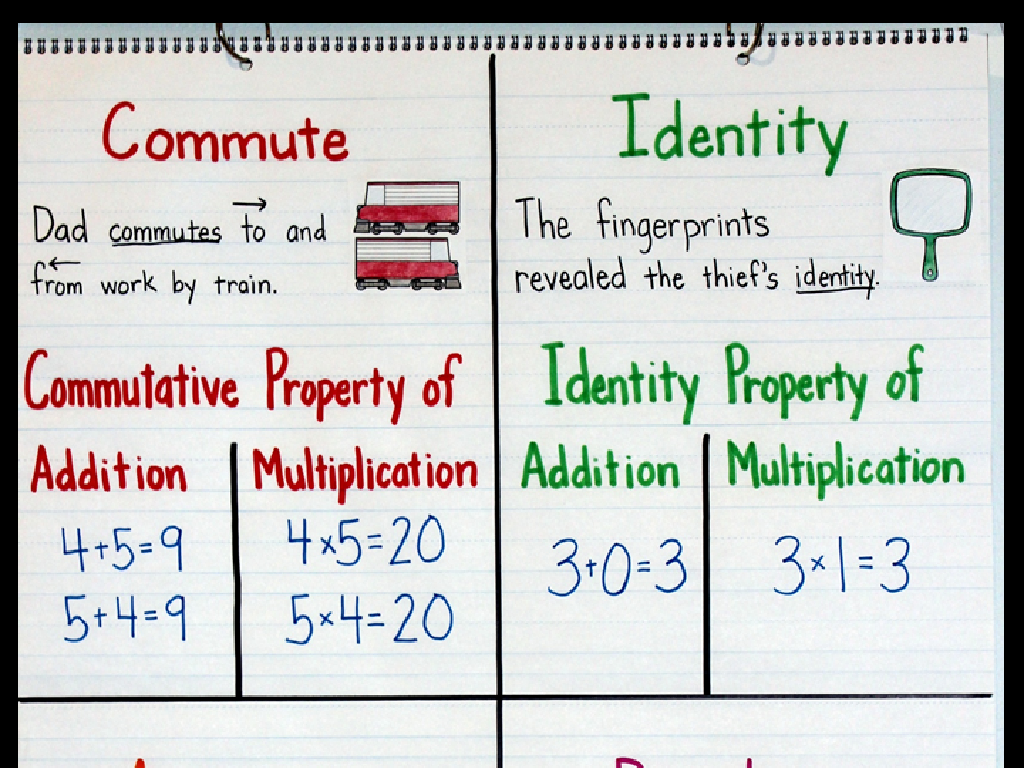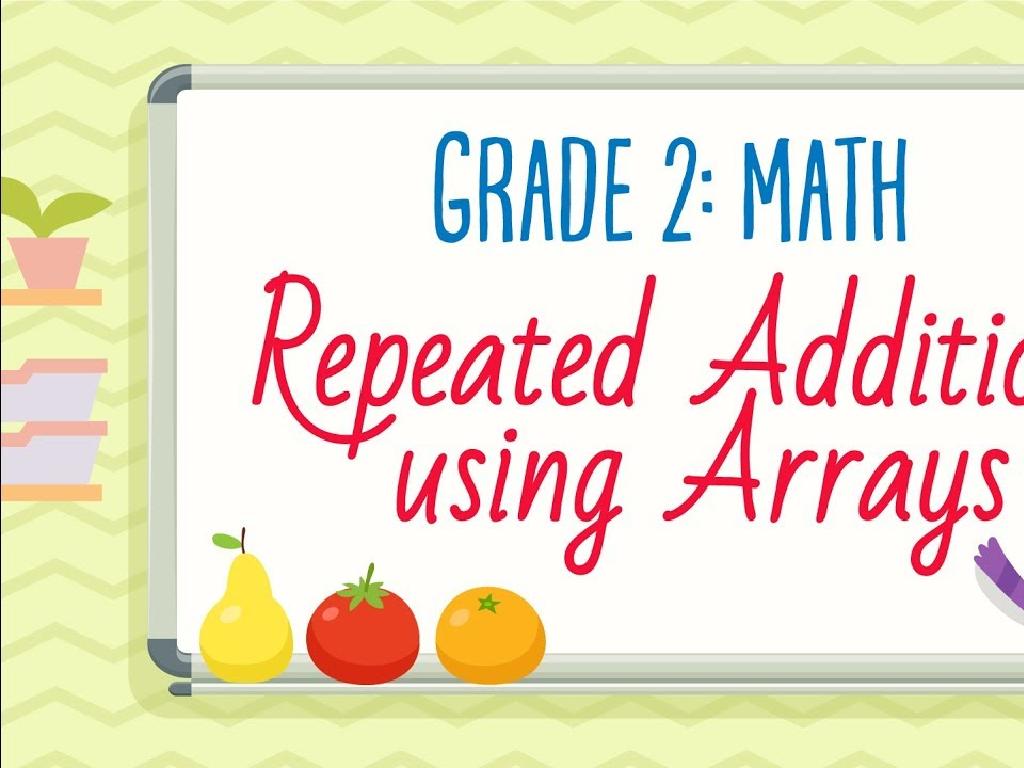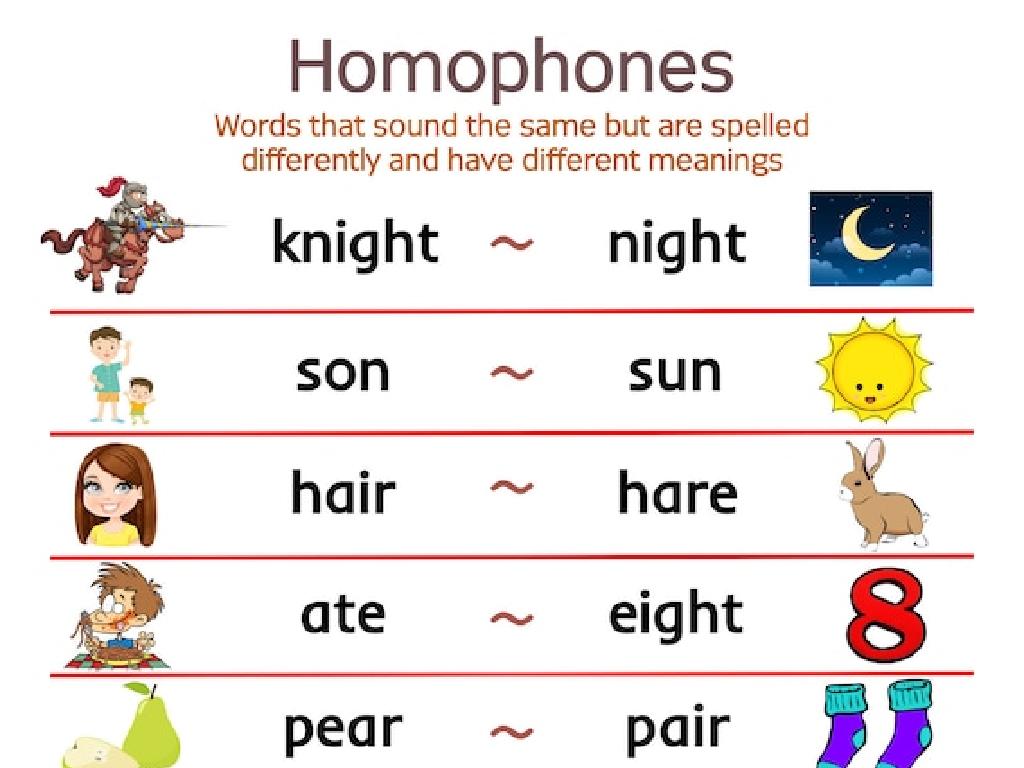Identify Possessive Pronouns
Subject: Language arts
Grade: Third grade
Topic: Pronouns
Please LOG IN to download the presentation. Access is available to registered users only.
View More Content
Today’s Adventure: Possessive Pronouns!
– What are possessive pronouns?
– Words that show who owns something, like ‘his’ or ‘her’.
– Why use possessive pronouns?
– To tell who something belongs to without repeating names.
– Examples of possessive pronouns
– ‘My’ toy, ‘your’ book, ‘her’ pencil, ‘our’ house.
– Practice identifying them
|
This slide introduces the concept of possessive pronouns to third graders, helping them understand how these special words are used to show ownership in a sentence. Start by explaining that pronouns are words that take the place of nouns. Then, focus on possessive pronouns, which are used to avoid repeating the owner’s name over and over again. Provide clear examples using common items that children relate to, like toys and books. Encourage the students to come up with their own examples and to practice by identifying possessive pronouns in sentences you provide. This will prepare them for an activity where they will find and use possessive pronouns in their own writing or in selected texts.
Possessive Pronouns: Showing Ownership
– What are possessive pronouns?
– Pronouns that tell us who something belongs to
– They show who owns something
– Instead of saying ‘the book of Tom’, we say ‘his book’
– Words like ‘mine’, ‘yours’, ‘ours’
– ‘Mine’ for me, ‘yours’ for you, ‘ours’ for us together
– ‘His’, ‘hers’, ‘theirs’ are also possessive
– ‘His’ for a boy, ‘hers’ for a girl, ‘theirs’ for a group
|
This slide introduces the concept of possessive pronouns to third-grade students. Possessive pronouns are used to show ownership and indicate who something belongs to without repeating the owner’s name. It’s important to provide examples and show that these pronouns make sentences shorter and easier to understand. Encourage students to practice by replacing nouns with possessive pronouns in sentences and to create their own examples. Reinforce the concept by having students identify possessive pronouns in their favorite books or in sentences you provide.
Possessive Pronouns: Making Sentences Smoother
– Avoid repeating nouns
– Use possessive pronouns
– They show who owns something without naming them again
– ‘The bicycle belongs to Sarah’
– ‘The bicycle is hers’
– ‘hers’ takes the place of ‘Sarah’s bicycle’
|
This slide is aimed at teaching third graders how to use possessive pronouns to avoid the repetition of nouns, making sentences smoother and easier to read. Possessive pronouns like ‘his’, ‘hers’, ‘theirs’, ‘ours’, ‘mine’, and ‘yours’ are used to show ownership and can replace nouns to prevent redundancy. For example, instead of saying ‘The bicycle belongs to Sarah’, which repeats the noun ‘bicycle’, we can use ‘The bicycle is hers’. This simplifies the sentence and directly shows possession. Encourage students to practice by taking sentences with repeated nouns and changing them to include possessive pronouns. This will help them understand the concept of ownership in grammar and improve their writing skills.
Your Turn: Identifying Possessive Pronouns
– Let’s practice with possessive pronouns
– I’ll show sentences, you pick the right pronoun
– Think: Who owns the item?
– Is it ‘his’, ‘her’, ‘their’, or ‘our’?
– Ready to show what you know?
|
This slide is an interactive class activity designed to help students practice identifying possessive pronouns. Start by explaining that possessive pronouns show ownership and can take the place of a noun. Give examples like ‘mine’, ‘yours’, ‘his’, ‘hers’, ‘ours’, ‘theirs’. Then, present sentences one by one and ask students to choose the correct possessive pronoun for each. Encourage them to think about who the owner is in each sentence. Possible activities: 1) Students write down the correct pronoun on a whiteboard and show it. 2) Pair students up and have them quiz each other. 3) Create a worksheet with sentences for students to fill in the blanks. 4) Use objects in the classroom and ask students to create sentences using possessive pronouns. 5) Have a relay race where students run to the board to write the correct pronoun for a given sentence.
Possessive Pronouns in Our Lives
– Spotting possessive pronouns daily
– They show who owns something, like ‘his’ book or ‘her’ apple.
– Using possessive pronouns for belongings
– Say ‘my’ toy instead of ‘the toy of mine’.
– Activity: Storytelling with possessive pronouns
– Tell a story about a favorite item using ‘my’, ‘your’, ‘our’.
– Understanding ‘mine’, ‘yours’, ‘theirs’
|
This slide introduces possessive pronouns and their usage in everyday language. Possessive pronouns like ‘my’, ‘your’, ‘his’, ‘her’, ‘its’, ‘our’, and ‘their’ indicate ownership and are used instead of adding ‘of’ and the owner’s name. The activity encourages students to practice using possessive pronouns by sharing stories about their favorite things. For example, a student might say, ‘My teddy bear is soft,’ instead of ‘The teddy bear of mine is soft.’ This exercise helps students to speak more naturally and to understand how possessive pronouns fit into sentences. Teachers should prepare to guide the storytelling activity, ensuring each student uses possessive pronouns correctly while sharing.
Game Time: Pronoun Treasure Hunt!
– Let’s play a possessive pronoun game
– Work in pairs to find pronouns
– Team up with a classmate for the hunt
– Look for pronouns around the classroom
– Search for ‘my’, ‘your’, ‘his’, ‘her’, ‘its’, ‘our’, ‘their’ on objects or walls
– Share your findings with the class
– Discuss the pronouns you found and where you found them
|
This interactive game is designed to help students identify possessive pronouns in a fun and engaging way. By working in pairs, students will search the classroom for labels, posters, or any written material that contains possessive pronouns. Encourage them to look for words like ‘my’, ‘your’, ‘his’, ‘her’, ‘its’, ‘our’, and ‘their’. After the hunt, each pair will have the opportunity to share their findings with the class, discussing where they found the pronouns and how they are used. This activity not only reinforces the concept of possessive pronouns but also fosters teamwork and public speaking skills. Prepare a list of 4-5 possible locations where pronouns might be found to guide the students if they need help.
Class Activity: Possessive Pronoun Art!
– Create an art piece with possessive pronouns
– Use magazines, stickers, or drawings
– Illustrate ‘yours’, ‘mine’, ‘ours’, etc.
– Show what these pronouns mean to you
– Display your art in our classroom
|
This activity is designed to help students understand possessive pronouns in a fun and creative way. Provide students with magazines, stickers, and drawing materials. They should create an art piece that visually represents possessive pronouns like ‘yours’, ‘mine’, ‘ours’, etc. Encourage them to think about items or things they would associate with each pronoun. For example, a student could draw a picture of a toy with ‘mine’ written underneath it. Once completed, plan to have a gallery walk where students can display and explain their art. This will help reinforce the concept of possessive pronouns and allow for a practical application of the lesson. Possible variations of the activity could include creating a collage, a poster, or even a digital presentation if resources allow.
Possessive Pronouns: Conclusion & Review
– Recap on possessive pronouns
– They show who owns something, like ‘his’ book or ‘her’ apple.
– Importance in sentences
– They help us avoid repeating names and make sentences clear.
– Personal possessive pronoun example
– Think of a sentence you said today that had ‘my’, ‘your’, ‘his’, ‘her’, ‘its’, ‘our’, or ‘their’.
– Class participation
|
As we wrap up, let’s review what we’ve learned about possessive pronouns. These pronouns are crucial because they show ownership and help us avoid repetition, making our sentences clearer and more concise. Ask students to reflect on their day and come up with sentences where they used possessive pronouns. This reinforces their understanding and demonstrates the practical use of possessive pronouns in daily communication. Encourage each student to share their example with the class to foster a collaborative learning environment.






